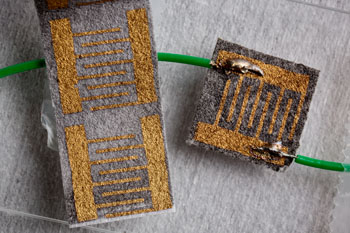Portable Sensor Rapidly Determines Extent of Eye Injury
By LabMedica International staff writers
Posted on 14 Dec 2015
Researchers have demonstrated a proof-of-concept for a novel point-of-care (POC) device that can quickly and inexpensively determine whether an eye injury is mild or severe. The sensor could speed efforts to determine extent of eye injury at locations such as accident sites, rural areas lacking ophthalmology specialists, and battlefields.Posted on 14 Dec 2015
The new “OcuCheck Biosensor” works by measuring vitamin C levels in the fluids that coat or leak from the eye, and was developed by a team led by Prof. Dipanjan Pan, Bioengineering, University of Illinois (Champaign, IL, USA) in collaboration with Dr. Leanne Labriola, ophthalmologist at Carle (Urbana, IL, USA). “The sensor takes advantage of the fact that the ocular tear film—the viscous fluid that coats the eyeball—contains low levels of ascorbic acid, which is just vitamin C, while the interior of the eye contains much higher levels,” said Prof. Pan, “So the concept is, if there is severe damage to the eye that penetrates deeply, the ascorbic acid will leak out in high concentration.”

Image: The new OcuCheck Biosensor can detect differences in vitamin C concentration in fluids that leak from the eye, where higher concentrations indicate a more severe injury, researchers report (Photo courtesy of L. Brian Stauffer and University of Illinois).
Currently, patients must reach a hospital to have eye injuries assessed for degree of severity. The process is often complicated, time-consuming, and imprecise. No current techniques for assessing eye injuries involve measurements of ascorbic acid (AA) “so this is a one-of-a-kind approach,” said Prof. Pan. “The new device will change the standard of care for evaluating eye traumas,” said Dr. Labriola.
OcuCheck uses graphene platelets layered 1 nm thick on filter paper. Upper layers include a unique polymer that interacts with the graphene, gold electrodes, and ascorbate oxidase, which binds to AA. “The idea is that the moment that the AA comes in and binds to the ascorbate oxidase, it will pull the polymer out of its interaction with the graphene,” changing the sensor’s electrical properties, said Prof. Pan.
Proof-of-concept was demonstrated by testing clinical samples from 16 patients undergoing eye surgery. OcuCheck coul—with high sensitivity, accuracy, and specificity—detect a range of AA concentrations. OcuCheck has not yet been tested on samples from trauma patients “but we have mixed the samples with blood, and the sensor’s sensitivity to AA is retained even in the presence of blood. The filter paper will filter out the blood,” said Prof. Pan.
The team is working with an industrial design professor to build a housing unit for the sensor. Prof. Pan and Dr. Labriola have founded a startup company, InnSight Technology, to help bring the device to market. “This is a perfect example of physicians and engineers working together to find solutions to current problems in health care,” said Prof. Pan, also referring to the Carle Illinois College of Medicine Carle Illinois College of Medicine (Urbana, IL, USA), a new engineering-based medical college soon to be established.
The paper, by Gartia MR, Misra SK et al., was published online in November 2015, in the journal Scientific Reports.
Related Links:
University of Illinois
Carle
Carle Illinois College of Medicine













